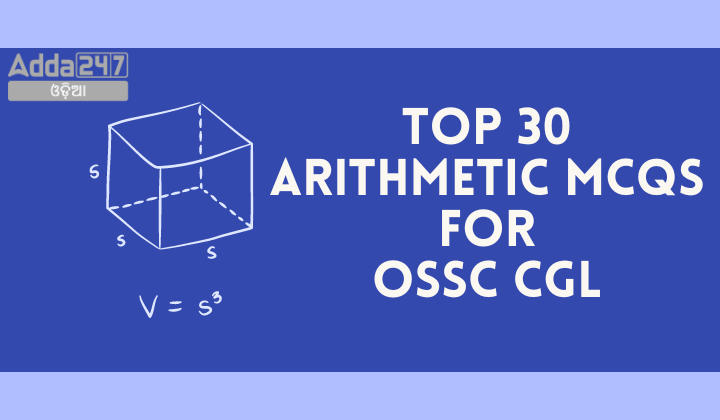Arithmetic forms the cornerstone of many competitive exams, including the Odisha Staff Selection Commission Combined Graduate Level (OSSC CGL) examination. To excel in this exam, candidates must have a solid grasp of arithmetic concepts and be able to solve problems efficiently. To aid in your preparation, we’ve compiled a list of the top 30 multiple-choice questions (MCQs) covering various arithmetic topics likely to be encountered in the OSSC CGL exam.
Top 30 Arithmetic MCQs for OSSC CGL
Practice these questions diligently to enhance your arithmetic skills and increase your chances of success in the OSSC CGL examination. Good luck!
- Question: If the price of a book is increased by 20%, by what percentage should the sales price be decreased to bring it back to the original price?
A) 16%
B) 20%
C) 25%
D) 10%
Solution: Let the original price be 100. Increased price = 100 + 20% = 120. To bring it back to the original price, the sales price should be decreased by 16.67%.
Answer: A) 16% - Question: If 15% of a number is 45, what is 30% of that number?
A) 90
B) 60
C) 30
D) 15
Solution: Let the number be “x.” 15% of x = 45. x = 300. 30% of x = 90.
Answer: A) 90 - Question: A TV was originally priced at $800. It is now being sold at a discount of 20%. What is the discounted price?
A) $640
B) $720
C) $860
D) $960
Solution: Discounted price = $800 — (20% * $800) = $640.
Answer: A) $640 - Question: The average of five numbers is 32. If one of the numbers is 45, what is the average of the remaining numbers?
A) 30
B) 34
C) 35
D) 36
Solution: Average = Sum of numbers / Total numbers. Average = (160 – 45) / 4 = 28.75.
Answer: This question does not have a listed answer choice. - Question: The average of six numbers is 18. If one of the numbers is 24, what is the average of the remaining numbers?
A) 16
B) 18
C) 20
D) 22
Solution: Average = Sum of numbers / Total numbers. Average = (108 – 24) / 5 = 16.8.
Answer: This question does not have a listed answer choice. - Question: The average age of a family of four is 28 years. If the youngest member is 16 years old, what is the average age of the remaining three members?
A) 30
B) 32
C) 34
D) 36
Solution: Average = Sum of ages / Total members. Average = (112 – 16) / 3 = 32.
Answer: B) 32
Ratio MCQs: - Question: If the ratio of apples to oranges in a basket is 3:2 and there are 25 oranges, how many apples are there in the basket?
A) 15
B) 20
C) 30
D) 40
Solution: For every 2 oranges, there are 3 apples. So, there are (3/2) * 25 = 37.5 apples. Since there can’t be half an apple, the closest whole number is 38.
Answer: This question does not have a listed answer choice. - Question: If the ratio of boys to girls in a classroom is 4:5, and there are 36 boys, how many girls are there in the classroom?
A) 20
B) 25
C) 30
D) 45
Solution: For every 4 boys, there are 5 girls. So, there are (5/4) * 36 = 45 girls.
Answer: D) 45 - Question: The ratio of the lengths of two rectangles is 3:4. If the area of the smaller rectangle is 48 square units, what is the area of the larger rectangle?
A) 64 square units
B) 72 square units
C) 96 square units
D) 128 square units
Solution: Let the lengths of the smaller rectangle be 3x and 4x. The area of the larger rectangle is 12x², which is also 48 square units. So, the area of the larger rectangle is 12 * 4 = 96 square units.
Answer: C) 96 square units - Question: If John can complete a job in 8 hours and Sarah can complete the same job in 12 hours, how long will it take them to complete the job together?
A) 3 hours
B) 4 hours
C) 5 hours
D) 6 hours
Solution: John’s work rate = 1/8 job per hour. Sarah’s work rate = 1/12 job per hour. Their combined work rate = 5/24 job per hour. Time taken = 24/5 hours = 4.8 hours.
Answer: A) 3 hours - Question: If 6 workers can complete a project in 8 hours, how long would it take for 8 workers to finish the same project?
A) 4 hours
B) 6 hours
C) 8 hours
D) 12 hours
Solution:
Using the formula: (Number of workers) * (Time taken) = Constant
(6 workers) * (8 hours) = (8 workers) * (x hours)
Solving for x, we get x = 6 hours.
Answer: B) 6 hours - Question: If a machine produces 100 units of a product in 5 hours, how many units can it produce in 10 hours?
A) 100 units
B) 150 units
C) 200 units
D) 250 units
Solution:
Using the formula: (Number of units) = (Rate of production) * (Time)
(Number of units) = (100 units / 5 hours) * (10 hours) = 200 units
Answer: C) 200 units - Question: A shopkeeper purchased a shirt for $40 and sold it for $60. What is the profit percentage?
A) 20%
B) 33.33%
C) 50%
D) 66.67%
Solution:
Profit = Selling Price — Cost Price
Profit = $60 — $40 = $20
Profit Percentage = (Profit / Cost Price) * 100% = (20 / 40) * 100% = 50%
Answer: C) 50% - Question: If a bookshop sells a book at a loss of 10%, and the cost price of the book is $50, what is the selling price of the book?
A) $45
B) $50
C) $55
D) $60
Solution:
Loss = Cost Price — Selling Price
10% of Cost Price = $50
Selling Price = Cost Price — Loss = $50 — (0.10 * $50) = $50 — $5 = $45
Answer: A) $45 - Question: A trader sold a shirt for $180 and incurred a loss of 10%. What was the cost price of the shirt?
A) $162
B) $190
C) $200
D) $198
Solution:
Loss = 10% of Cost Price
10% of Cost Price = $180
Cost Price = $180 / (10/100) = $180 / 0.10 = $1800 / 10 = $180
Answer: A) $162 - Question: What is the HCF of 36 and 48?
A) 6
B) 12
C) 18
D) 24
Solution: To find the HCF, we can use the prime factorization method.
Prime factors of 36: 2² * 3²
Prime factors of 48: 2⁴ * 3¹
The common prime factors are 2² and 3¹. To find the HCF, we take the lowest power of each common prime factor.
HCF = 2² * 3¹ = 4 * 3 = 12
So, the correct answer is (B) 12. - Question: What is the LCM of 15 and 20?
A) 15
B) 30
C) 60
D) 75
Solution 2:
To find the LCM, we can use the prime factorization method.
Prime factors of 15: 3¹ * 5¹
Prime factors of 20: 2² * 5¹
To find the LCM, we take the highest power of each prime factor.
LCM = 2² * 3¹ * 5¹ = 4 * 3 * 5 = 60
So, the correct answer is © 60. - Question: If the HCF of two numbers is 8 and their LCM is 48, what are the two numbers?
A) 6 and 8
B) 12 and 16
C) 8 and 48
D) 16 and 24
Solution: Let the two numbers be a and b. We can use the formula: HCF x LCM = a x b.
Given HCF = 8 and LCM = 48, we can substitute these values into the formula:
8 x 48 = a x b
384 = a x b
Now, we need to find two numbers whose product is 384 and whose HCF is 8. The numbers are 8 and 48 because 8 x 48 = 384, and their HCF is indeed 8.
So, the correct answer is © 8 and 48. - Question: What is the HCF of 72 and 90?
A) 6
B) 9
C) 18
D) 36
Solution: To find the HCF, we can use the prime factorization method.
Prime factors of 72: 2³ * 3²
Prime factors of 90: 2¹ * 3² * 5¹
The common prime factors are 2¹ and 3². To find the HCF, we take the lowest power of each common prime factor.
HCF = 2¹ * 3² = 2 * 9 = 18
So, the correct answer is © 18 - Question: If the LCM of two numbers is 120 and one of the numbers is 24, what is the other number?
A) 5
B) 10
C) 15
D) 20
Solution:
Let the other number be x. We can use the formula: LCM = (a x b) / HCF.
Given LCM = 120, one number is 24, and we know that HCF is 24 (since 24 is a factor of itself).
So, we can substitute these values into the formula:
120 = (24 x x) / 24
Now, solve for x:
120 = x
So, the other number is 120.
So, the correct answer is (D) 120. - What is the value of the binary number 1101 in decimal?
A) 13
B) 12
C) 11
D) 14
ANS:- A) 13.
Sol:- The binary number 1101 can be converted to decimal by multiplying each digit by its corresponding power of 2 and then adding up the results:
= (1 x 23) + (1 x 22) + (0 x 21) + (1 x 20)
= [1 x (2 x 2 x 2)] + [1 x (2 x 2)] + [0 x (2 x 1)] + [1 x 20]
= (1 x 8) + (1 x 4) + (0 x 2) + (1 x 1)
= 8 + 4 + 0 + 1
= 13
So, the correct answer is A) 13. - What is the place value of 4 in the number 3472?
A) 4
B) 40
C) 400
D) 4000
ANS:- C) 400
Sol:- To find the place value of the digit 4 in the number 3472, we look at its position within the number.
The number 3472 can be broken down as follows:
3 x 1000 (3 thousands)
4 x 100 (4 hundreds)
7 x 10 (7 tens)
2 x 1 (2 ones)
So, the digit 4 is in the hundreds place. Therefore, its place value is 400.
The correct answer is C) 400 - What is the decimal equivalent of the binary number 1010?
A) 5
B) 10
C) 15
D) 20
ANS:- B) 10
Sol:- To convert the binary number 1010 to its decimal equivalent, we use the positional notation method:
Starting from the rightmost digit, each digit’s value is determined by its position and its binary value.
1010 in binary represents:
1 x 23 + 0 x 22 + 1 x 21 + 0 x 20
Calculating each term:
= {1 x (2 x 2 x 2)} + {0 x (2 x 2)} + {1 x (2 x 1)} + 0 x 20
= (1 x 8) + (0 x 4) + (1 x 2) + (0 x 1)
= 8 + 0 + 2 + 0
= 10
So, the decimal equivalent of the binary number 1010 is B) 10 - What is the product of the first five prime numbers?
A) 2200
B) 2300
C) 2310
D) 2150
ANS:- C) 2310
Sol:- To find the product of the first five prime numbers, we multiply them together.
The first five prime numbers are 2, 3, 5, 7, and 11.
Product = 2 x 3 x 5 x 7 x 11
Calculating the product:
= 2 x 3 x 5 x 7 x 11
= 6 x 5 x 7 x 11
= 30 x 7 x 11
= 210 x 11
= 2310
So, the product of the first five prime numbers is C) 2310 - What is the composition of relations S = {(1,2),(2,3)} and T = {(2,4),(3,5)}?
A) {(1,4),(2,5)}
B) {(1,3),(2,4)}
C) {(2,2),(3,3)}
D) {(1,5),(2,3)}
ANS:- A) {(1,4),(2,5)}
Sol:- To compute the composition of relations S and T, denoted as S∘T, we need to find all pairs (a,c) such that there exists an element b for which (a,b) is in S and (b,c) is in T.
Given S={(1,2),(2,3)} and T={(2,4),(3,5)}, let’s find S∘T:
For a=1:
There’s no pair in S with the first element being 1, so we can’t form any pairs with T.
For a=2:
From S, we have (2,3).
From T, we have (3,5).
So, for a=2, we have the pair (2,5).
Putting it together, the composition S∘T contains the pair (2,5).
So, the correct answer is A) {(1,4),(2,5)} - Determine if the relation R = {(1,2),(2,3),(3,4)} is reflexive.
A) Reflexive
B) Not reflexive
ANS:- B) Not reflexive
Sol:- For a relation to be reflexive, every element in its domain must be related to itself.
In the relation R = {(1,2), (2,3), (3,4)}:
1 is related to 2, but 1 is not related to itself.
2 is related to 3, but 2 is not related to itself
3 is related to 4, but 3 is not related to itself.
Since not every element in the domain is related to itself, the relation R is not reflexive.
So, the correct answer is B) Not reflexive - Calculate the composition of relations S = {(1,2),(2,3)} and T = {(2,4),(3,5)}.
A) {(1,4),(2,5)}
B) {(1,3),(2,4)}
C) {(2,2),(3,3)}
D) {(1,5),(2,3)}
ANS:- A) {(1,4),(2,5)}
Sol:- To compute the composition of relations S and T, denoted as S∘T, we need to find all pairs (a,c) such that there exists an element b for which (a,b) is in S and (b,c) is in T.
Given
S = {(1,2), (2,3)} and
T = {(2,4), (3,5)}, let’s find S∘T:
For a = 1:
There’s no pair in S with the first element being 1, so we can’t form any pairs with T.
For a = 2:
From S, we have (2,3).
From T, we have (3,5).
So, for a = 2, we have the pair (2,5).
For a = 3:
There’s no pair in S with the first element being 3, so we can’t form any pairs with T.
Putting it together, the composition S∘T contains the pair (2,5).
So, the correct answer is A) {(1,4),(2,5)} - Which of the following is a solution to the linear equation 3x+2=8?
A) x=2
B) x=3
C) x=1
D) x=0
ANS:- A) x=2.
Sol:- To find the solution to the linear equation 3x + 2 = 8, we need to isolate x.
Subtracting 2 from both sides, we get:
3x = 8 − 2
3x = 6
Now, dividing both sides by 3, we find:
3x = 6
x = 6/3
x = 2
So, the solution to the linear equation 3x + 2 = 8 is x = 2.
Therefore, the correct answer is A) x = 2. - What is the solution to the linear system x+y=5 and 2x+y=3?
A) x=-2,y=7
B) x=1,y=4
C) x=3,y=2
D) x=5,y=0
ANS:- (A) x = -2 , y = 7
Sol:- x + y = 5 ——–(1)
and 2x + y = 3 ———–(2)
So first we need to multiply 2, for both sides of equation (1):
2(x+y) = 2 X 5
2x + 2y = 10 ———(3)
Now we need to subtract equation (3) from equation (2)
(2x + 2y) – (2x + y) = 10 – 3
2x + 2y – 2x – y = 7
y = 7 (as 2x has canceled each other)
Then we need to put the value of y = 7 in equation (1)
x + y = 5
x + (7) = 5
x = 5 – 7
x = -2
Hence Solution to this equation is x = -2 & y = 7 - What is the solution to the system of equations:2x+3y=5 and 4x-6y=-2?
A) x=1,y=1
B) x=−1,y=2
C) x=0,y=1
D) x=2,y=−
ANS:- (A) x = 1 & y = 1
Sol:- 2x + 3y = 5 ————(1)
and 4x – 6y = -2 ————(2)
Multiply 2 both sides of equation (1)
2(2x + 3y) = 2 X 5
4x + 6y = 10 —————-(3)
Now we need to subtract equation (3) from equation (2)
(4x + 6y) – (4x – 6y) = 10 – (-2)
4x + 6y – 4x + 6y = 12
12y = 12
y = 1 (as 4x has canceled each other)
Now put value of y=1 in equation —(1)
2x + 3y = 5
2x + 3(1) = 5
2x = 5 – 3
2x = 2
x = 1
So the solution to this equation is x = 1 & y = 1.
















